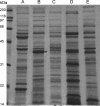A metalloprotease secreted by the insect pathogen Photorhabdus luminescens induces melanization
- PMID: 17933944
- PMCID: PMC2168055
- DOI: 10.1128/AEM.01000-07
A metalloprotease secreted by the insect pathogen Photorhabdus luminescens induces melanization
Abstract
Photorhabdus luminescens is a gram-negative insect pathogen that enters the hemocoel of infected hosts and produces a number of secreted proteins that promote colonization and subsequent death of the insect. In initial studies to determine the exact role of individual secreted proteins in insect pathogenesis, concentrated culture supernatants from various P. luminescens strains were injected into the tobacco hornworm Manduca sexta. Culture supernatants from P. luminescens TT01, the genome-sequenced strain, stimulated a rapid melanization reaction in M. sexta. Comparison of the profiles of secreted proteins from the various Photorhabdus strains revealed a single protein of approximately 37 kDa that was significantly overrepresented in the TT01 culture supernatant. This protein was purified by DEAE ion-exchange and Superdex 75 gel filtration chromatography and identified by matrix-assisted laser desorption ionization-time of flight analysis as the product of the TT01 gene plu1382 (NCBI accession number NC_005126); we refer to it here as PrtS. PrtS is a member of the M4 metalloprotease family. Injection of PrtS into larvae of M. sexta and Galleria mellonella and into adult Drosophila melanogaster and D. melanogaster melanization mutants (Bc) confirmed that the purified protein induced the melanization reaction. The prtS gene was transcribed by P. luminescens injected into M. sexta before death of the insect, suggesting that the protein was produced during infection. The exact function of this protease during infection is not clear. The bacteria might survive inside the insect despite the melanization process, or it might be that the bacterium is specifically activating melanization in an attempt to circumvent this innate immune response.
Figures






Similar articles
-
RNAi suppression of recognition protein mediated immune responses in the tobacco hornworm Manduca sexta causes increased susceptibility to the insect pathogen Photorhabdus.Dev Comp Immunol. 2006;30(12):1099-107. doi: 10.1016/j.dci.2006.02.008. Epub 2006 Mar 29. Dev Comp Immunol. 2006. PMID: 16620974
-
Prior infection of Manduca sexta with non-pathogenic Escherichia coli elicits immunity to pathogenic Photorhabdus luminescens: roles of immune-related proteins shown by RNA interference.Insect Biochem Mol Biol. 2006 Jun;36(6):517-25. doi: 10.1016/j.ibmb.2006.04.001. Epub 2006 Apr 17. Insect Biochem Mol Biol. 2006. PMID: 16731347
-
The role of iron uptake in pathogenicity and symbiosis in Photorhabdus luminescens TT01.BMC Microbiol. 2010 Jun 22;10:177. doi: 10.1186/1471-2180-10-177. BMC Microbiol. 2010. PMID: 20569430 Free PMC article.
-
Comparative analysis of the Photorhabdus luminescens and the Yersinia enterocolitica genomes: uncovering candidate genes involved in insect pathogenicity.BMC Genomics. 2008 Jan 25;9:40. doi: 10.1186/1471-2164-9-40. BMC Genomics. 2008. PMID: 18221513 Free PMC article. Review.
-
Toxins and secretion systems of Photorhabdus luminescens.Toxins (Basel). 2010 Jun;2(6):1250-64. doi: 10.3390/toxins2061250. Epub 2010 Jun 1. Toxins (Basel). 2010. PMID: 22069636 Free PMC article. Review.
Cited by
-
Mutations that impact the enteropathogenic Escherichia coli Cpx envelope stress response attenuate virulence in Galleria mellonella.Infect Immun. 2012 Sep;80(9):3077-85. doi: 10.1128/IAI.00081-12. Epub 2012 Jun 18. Infect Immun. 2012. PMID: 22710873 Free PMC article.
-
GI-type T4SS-mediated horizontal transfer of the 89K pathogenicity island in epidemic Streptococcus suis serotype 2.Mol Microbiol. 2011 Mar;79(6):1670-83. doi: 10.1111/j.1365-2958.2011.07553.x. Epub 2011 Feb 10. Mol Microbiol. 2011. PMID: 21244532 Free PMC article.
-
The insight into the biology of five homologous lectins produced by the entomopathogenic bacterium and nematode symbiont Photorhabdus laumondii.Glycobiology. 2025 Jun 2;35(7):cwaf033. doi: 10.1093/glycob/cwaf033. Glycobiology. 2025. PMID: 40459235 Free PMC article.
-
Immunity in lepidopteran insects.Adv Exp Med Biol. 2010;708:181-204. doi: 10.1007/978-1-4419-8059-5_10. Adv Exp Med Biol. 2010. PMID: 21528699 Free PMC article. Review.
-
Protease S of entomopathogenic bacterium Photorhabdus laumondii: expression, purification and effect on greater wax moth Galleria mellonella.Mol Biol Rep. 2024 Jun 1;51(1):713. doi: 10.1007/s11033-024-09654-8. Mol Biol Rep. 2024. PMID: 38824247
References
-
- Bowen, D., T. Rocheleau, M. Blackburn, O. Andreev, E. Golubeva, R. Bhartia, and R. ffrench-Constant. 1998. Insecticidal toxins from the bacterium Photorhabdus luminescens. Science 280:2129-2132. - PubMed
-
- Bowen, D. J., T. Rocheleau, C. K. Grutzmacher, L. Meslet, M. Valens, D. Marble, A. Dowling, R. ffrench-Constant, and M. A. Blight. 2003. Genetic and biochemical characterization of PrtA, an RTX-like metalloprotease from Photorhabdus. Microbiology 149:1581-1591. - PubMed
Publication types
MeSH terms
Substances
Associated data
- Actions
LinkOut - more resources
Full Text Sources
Molecular Biology Databases

